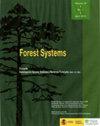Monitoring the dynamic changes in vegetation cover and driving factors from 2000 to 2020 in the Maoershan Forest Farm region, China, using satellite remote sensing data
IF 0.7
4区 农林科学
Q3 FORESTRY
引用次数: 0
Abstract
Aim of study: Natural climate change is a central driver of global ecosystem and forest change. Climate change and topographical factors have had the greatest impact on different types of forests around the world. We used remote sensing technology to detect and analyze the temporal and spatial changes of forest vegetation to provide reference for regional management. Area of study: Maoershan Forest Farm, China. Material and methods: The Landsat images were preprocessed using ArcGIS and ENVI software. The normalized difference vegetation index (NDVI) was calculated to identify vegetation changes from 2000 to 2020. In addition, the vegetation fraction cover (VFC) was calculated using the pixel binary model. The driving factors and their influences on vegetation changes in this region were determined using the random forest algorithm and Pearson correlation analysis method. Main results: From 2000 to 2020, the NDVI showed an overall increasing trend. The results indicated that compared with the climatic factors, topographic factors were more important to vegetation growth in the study area. Among the topographic factors, elevation was the most important factor affecting vegetation growth and both showed a negative correlation. Among the climatic factors, relative humidity was the primary driving factor affecting vegetation growth and both showed a positive correlation. Research highlights: Accurate and timely assessment of vegetation change and its relationship to climate and topographical changes can provide very useful information for policy makers, governments and planners in formulating management policies.2000 - 2020年毛尔山林场植被覆盖动态变化及其驱动因素的卫星遥感监测
研究目的:自然气候变化是全球生态系统和森林变化的核心驱动因素。气候变化和地形因素对世界各地不同类型森林的影响最大。我们利用遥感技术对森林植被的时空变化进行了检测和分析,为区域管理提供参考。研究区域:中国毛耳山林场。材料与方法:利用ArcGIS和ENVI软件对陆地卫星图像进行预处理。计算归一化差异植被指数(NDVI),以确定2000年至2020年的植被变化。此外,还使用像素二元模型计算了植被覆盖率(VFC)。采用随机森林算法和Pearson相关分析方法,确定了该地区植被变化的驱动因素及其影响因素。主要结果:2000-2002年,NDVI总体呈上升趋势。结果表明,与气候因素相比,地形因素对研究区植被生长的影响更大。在地形因素中,海拔是影响植被生长的最重要因素,两者呈负相关。在气候因素中,相对湿度是影响植被生长的主要驱动因素,两者呈正相关。研究亮点:准确、及时地评估植被变化及其与气候和地形变化的关系,可以为决策者、政府和规划者制定管理政策提供非常有用的信息。
本文章由计算机程序翻译,如有差异,请以英文原文为准。
求助全文
约1分钟内获得全文
求助全文
来源期刊

Forest Systems
FORESTRY-
CiteScore
1.40
自引率
14.30%
发文量
30
审稿时长
6-12 weeks
期刊介绍:
Forest Systems is an international peer-reviewed journal. The main aim of Forest Systems is to integrate multidisciplinary research with forest management in complex systems with different social and ecological background
 求助内容:
求助内容: 应助结果提醒方式:
应助结果提醒方式:


